The establishment of the “Irish Provisional Government” on 16 January 1922 seemed to take the (Irish) post office by surprise. Although work must have started on designs preparatory to independence these did not appear until 6 December 1922 (the 2d “map”, which, it should be noted, includes Northern Ireland within the boundaries of Ireland). As a result, a series of temporary overprints was arranged, the first of which appeared on 17 February; these arrangements seem to have been rather hasty, as no fewer than four printers were used – Dollard and Thom for the early sets, Harrison for the coils, Government Printing Works and Harrison for the 1925-1935 “Seahorses”. Unoverprinted British stamps with Irish postmarks between 16 January and the issue of overprinted stamps attract a significant premium. In the meantime there were also a few unofficial handstamps, presumably to make a political point (see political propaganda).
Although the issues look complicated, in fact only 4 values (1½d, 2d, 6d, 1/-, in the 5-line overprint, numbers 3/29, 4/30, 5/31, 10/36, 13/40) are difficult to distinguish. There are a great many minor varieties in the lettering in all issues, and many minor re-entries on the Seahorses.
In parallel to the postage issues, all the many revenue issues also appeared with the different overprints. It is a truly complex 12 months of overprints!
British postage dues continued in use in Ireland until 1925 – since they had no country designation or King’s head they were allegedly deemed not to need an overprint. However, the nation was clearly not so anxious about the appearance of the British monarch’s head on their stamps, since the King George VI “seahorse” high values continued to be overprinted for use in Ireland until 1937, 15 years later.
In the confused and hasty hand-over of power, a remarkable bureaucratic oversight arose. Because of lax wording in the 1922 Post Office Act which gave the Irish overprinted stamps the same validity as unoverprinted ones, the Irish issues were also inadvertently rendered valid for use in any colony which used GB stamps, including (for example) Ascension. Such usage, however obviously philatelic, is keenly sought after. The anomaly was quickly corrected (Robson Lowe, 1952, p.398).
Irish Provisional Government
KGV, 1922 Overprinted by Dollard and Thom
Overprinted “Rialtas Sealadaċ na hEireann 1922” in 5 lines
Dollard – long “9” in 1922
Thom – short “9” in 1922, 14½ mm * 16 mm, dull black to grey (1½d, 2d, 6d, 1/-)
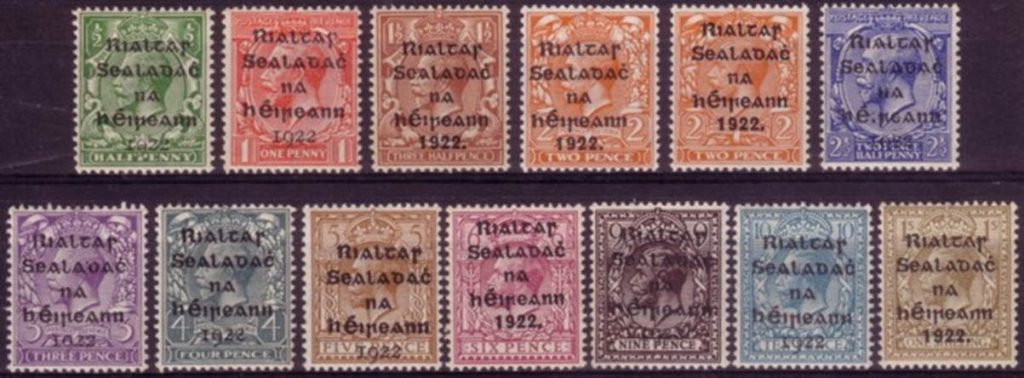
| (SG №) | denomination | colour | date of issue | Printer | number issued |
|---|---|---|---|---|---|
| 1 | ½d | Green | 17/02/1922 | Dollard | 10,320,000 |
| 2 | 1d | Scarlet | 17/02/1922 | Dollard | 26,880,000 |
| 3 | 1d | Carmine Red | 17/02/1922 | Dollard | (inc. above total) |
| 4 | 2½d | Bright Blue | 17/02/1922 | Dollard | 360,480 |
| 5 | 3d | Bluish Violet | 17/02/1922 | Dollard | 1,560,000 |
| 6 | 4d | Grey Green | 17/02/1922 | Dollard | 408,480 |
| 7 | 5d | Yellow Brown | 17/02/1922 | Dollard | 504,000 |
| 8 | 9d | Agate | 17/02/1922 | Dollard | 575,520 |
| 9 | 10d | Turquoise Blue | 17/02/1922 | Dollard | 216,000 |
| 10 | 1½d | Red Brown | 17/02/1922 | Thom | 960,000 |
| 12 | 2d (die I) | Orange | 17/02/1922 | Thom | 9,600,000 |
| 13 | 2d (die II) | Orange | 17/02/1922 | Thom | (inc. above total) |
| 14 | 6d (chalky) | Reddish Purple | 17/02/1922 | Thom | 480,000 |
| 15 | 1s | Bistre Brown | 17/02/1922 | Thom | 480,000 |
| Varieties | ||
|---|---|---|
KGV, 1922 High Values (Bradbury Wilkinson) Overprinted by Dollard

| (SG №) | denomination | colour | date of issue | Printer | number issued |
|---|---|---|---|---|---|
| 17 | 2s6d | Sepia Brown | 17/02/1922 | Dollard | 40,000 |
| 18 | 2s6d | Reddish Brown | 17/02/1922 | Dollard | (inc. above total) |
| 19 | 5s | Rose Carmine | 17/02/1922 | Dollard | 26,000 |
| 20 | 10s | Dull Grey Blue | 17/02/1922 | Dollard | 20,000 |
| Varieties | ||
|---|---|---|
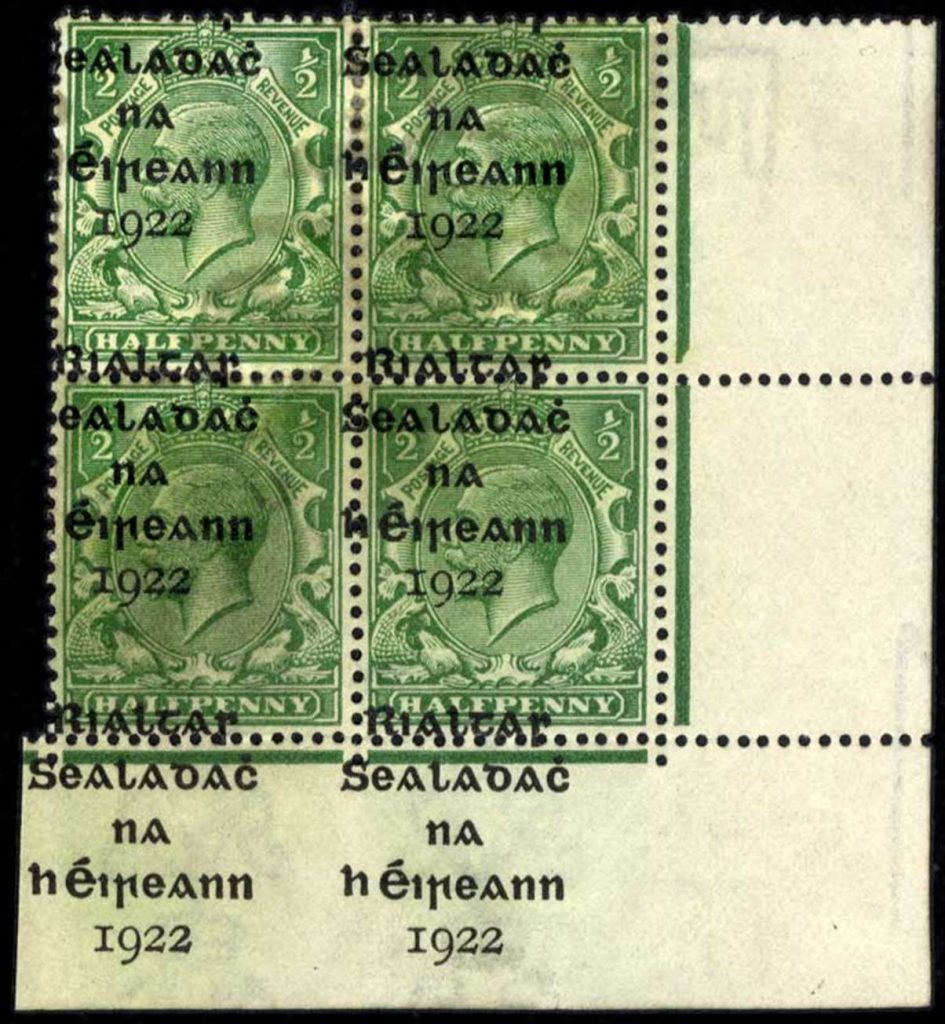
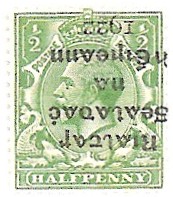
1922 Coil stamps, overprinted by Harrison and Sons in London
Singles from horizontal coils can be distinguished from vertical coils by the guillotining of the edges: horizontal coils have the top and bottom perfs guillotined rather than torn, in the vertical coils the side edges are guillotined; many copies are guillotined badly, and used copies from horizontal coils are often also badly miscut on the vertical sides because of misaligned automatic affixing machines. The 1d came mostly from horizontal coils. The 2d die II was not issued in coils unoverprinted in the UK.
For the difference between 2d die I and die II see above: since the coils were joined from cut up sheets rather than in continuous rolls it is possible to get 2d coil joins where one stamp is die I and the other is die II, though it is obviously easy to fake these.
On the joins of vertical strips some of the vertical strips will have come from the column below which the control letter would appear in the margin used for joining the strips, but there appear to be no reports of such joins in which enough of the bottom margin remaining to show part of the control xxx check, and check whether the join used the top margin or bottom margin.
Note: the Irish printers lacked the machinery to make up the coils
overprint 15 mm * 17 mm, vertical and horizontal coils

| (SG №) | denomination | colour | date of issue | Printer | number issued |
|---|---|---|---|---|---|
| 26 | ½d | Green | 19/06/1922 | Harrison | 236,000+ |
| 27 | 1d | Scarlet | 19/06/1922 | Harrison | 690,000+ |
| 28 | 1½d | Red Brown | 19/06/1922 | Harrison | 56,000+ |
| 29 | 2d | Bright Orange (die I) | 19/06/1922 | Harrison | 322,000+ |
| 29a | 2d | Bright Orange (die II) | Aug 1922 | Harrison | 393,000+ |
| Varieties | ||
|---|---|---|
1922, Overprints by Thom
Change of colour of overprint
Thom took over all the overprinting but used bolder blue-black and red on selected values. The 1½d, 2d, 6d, 1/- are difficult to distinguish from the first set



| (SG №) | denomination | colour | date of issue | Ink Colour | number issued |
|---|---|---|---|---|---|
| 30 | ½d | Green | June 1922 | Bold Blue Black | |
| 31 | 1d | Scarlet | June 1922 | Bold Blue Black | |
| 32 | 1½d | Red Brown | June 1922 | Bold Blue Black | |
| 32a | 1½d | Chestnut | June 1922 | Bold Blue Black | |
| 33 | 2d (die 1) | Orange | June 1922 | Bold Blue Black | |
| 34 | 2d (die II) | Orange | June 1922 | Bold Blue Black | |
| 35 | 2½d | Blue | June 1922 | Bold Red | |
| 36 | 3d | Violet | June 1922 | Bold Blue Black | |
| 37 | 4d | Grey Green | June 1922 | Bold Red | |
| 38 | 5d | Yellow Brown | June 1922 | Bold Blue Black | |
| 39 | 6d | Reddish Purple (Chalky) | June 1922 | Bold Blue Black | |
| 39a | 6d | Deep Reddish Purple | June 1922 | Bold Blue Black | |
| 40 | 9d | Agate | June 1922 | Bold Red | |
| 41 | 9d | Olive Green | October 1922 | Bold Red | |
| 42 | 10d | Turquoise Blue | June 1922 | Bold Blue Black | |
| 43 | 1s | Bistre Brown | June 1922 | Bold Blue Black |
| Varieties | ||
|---|---|---|
KGV, 1922 High Values (Bradbury Wilkinson) Overprinted by Thom
Bolder print than earlier high values using shiny, blue black ink.

| (SG №) | denomination | colour | date of issue | Printer | number issued |
|---|---|---|---|---|---|
| 44 | 2s6d | Sepia Brown | Oct 1922 | Thom | 10,000 |
| 45 | 5s | Rose Carmine | Nov 1922 | Thom | 8,000 |
| 46 | 10s | Dull Grey Blue | Oct 1922 | Thom | 6,000 |
| Varieties | ||
|---|---|---|
KGV, 1922 Thom wider overprint
Overprint measures 15.7 mm * 16 mm and it is not clear why Thom reset the overprint to this wider setting.

| (SG №) | denomination | colour | date of issue | Printer | number issued |
|---|---|---|---|---|---|
| 47 | ½d | Green | 21/11/1922 | Thom | 720,000 |
| 48 | 1d | Scarlet | 21/11/1922 | Thom | 1,680,000 |
| 49 | 1½d | Red Brown | 04/12/1922 | Thom | 600,000 |
| 50 | 2d | Orange (die II) | 21/11/1922 | Thom | 1,440,000 |
| 51 | 1s | Olive Bistre | 21/11/1922 | Thom | 240,000 |
| Varieties | ||
|---|---|---|
Irish Free State
On 6 December 1922 the status of the country changed to “Irish Free State” so a revised overprint was applied to the British stamps. The stamps engraved “Eire” were gradually released during 1922 and 1923, and overlapped with some of the later overprinted stamps.
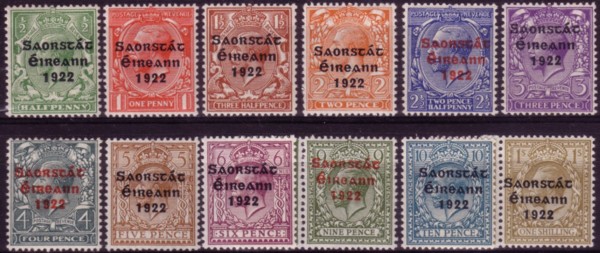
| (SG №) | denomination | colour | date of issue | Ink Colour | number issued |
|---|---|---|---|---|---|
| 52 | ½d | Green | 18/12/1922 | Shiny Blu/Black | |
| 53 | 1d | Scarlet | 16/12/1922 | Shiny Blu/Black | |
| 54 | 1½d | Red Brown | 21/12/1922 | Shiny Blu/Black | |
| 55 | 2d (die II) | Orange | 11/12/1922 | Shiny Blu/Black | |
| 56 | 2½d | Bright Blue | 06/01/1923 | Red | |
| 57 | 3d | Violet | 06/01/1923 | Shiny Blu/Black | |
| 58 | 4d | Grey Green | 16/01/1923 | Red | |
| 59 | 5d | Yellow Brown | 23/12/1922 | Shiny Blu/Black | |
| 60 | 6d | Reddish Purple (Chalky) | 23/12/1923 | Shiny Blu/Black | |
| 61 | 9d | Olive Green | 21/12/1922 | Red | |
| 62 | 10d | Turquoise Blue | 13/01/1923 | Shiny Blu/Black | |
| 63 | 1s | Bistre Brown | 21/12/1922 | Shiny Blu/Black |
| Varieties | ||
|---|---|---|
The Irish Free State
KGV, 1922 High Values (Bradbury Wilkinson) Overprinted by Thom
Further later printing of Seahorses

| (SG №) | denomination | colour | date of issue | Printer | number issued |
|---|---|---|---|---|---|
| 64 | 2s6d | Chocolate Brown | 21/12/1922 | Thom | |
| 64aa | 2s6d | Pale Brown | 21/12/1922 | Thom | |
| 65 | 5s | Rose Carmine | 28/12/1922 | Thom | |
| 66 | 10s | Dull Grey Blue | 28/12/1922 | Thom |
| Varieties | ||
|---|---|---|
KGV, 1923, Coil stamps, overprinted by Harrison in London
Coil stamps, overprinted by Harrisons in London
Note: the Irish printers lacked the machinery to make up the coils
These can be distinguished from the sheet overprints by the foot of the “1” being rounded instead of square (see illustration below), and (of course) by the edges being guillotined for use in coil machines. Most ½d, 1d and 2d stamps are in horizontal coils, most 1½d in vertical coils. The 2d die II was not issued in coils unoverprinted in the UK.
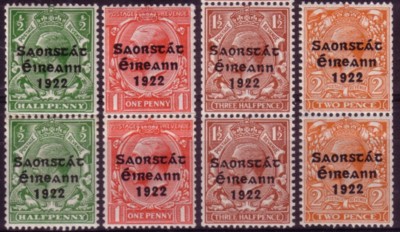

The square foot sheet stamp, round foot coil stamp, and the “long 1” variety (the latter can be found both on horizontal and vertical coils, including several of those illustrated above).
| (SG №) | denomination | colour | date of issue | Printer | number issued |
|---|---|---|---|---|---|
| 67 | ½d | Green | 07/03/1923 | Harrison | 265,000+ |
| 68 | 1d | Scarlet | 07/03/1923 | Harrison | 144,000+ |
| 69 | 1½d | Red Brown | 07/03/1923 | Harrison | 23,000+ |
| 70 | 2d | Orange (die II) | 07/03/1923 | Harrison | 144,000+ |
| Varieties | ||
|---|---|---|
KGV, 1925 High Values (Bradbury Wilkinson) Overprinted the Government Printing Works in Dublin
Narrow date, grey black overprint
| (SG №) | denomination | colour | date of issue | Printer | number issued |
|---|---|---|---|---|---|
| 83 | 2s6d | Chocolate Brown | 25/08/1925 | Government printers of Dublin | |
| 84 | 5s | Rose Carmine | 25/08/1925 | Government printers of Dublin | |
| 85 | 10s | Dull Grey Blue | 25/08/1925 | Government printers of Dublin |
| Varieties | ||
|---|---|---|
KGV, 1927 High Values (Bradbury Wilkinson) Overprinted by the Government Printing Works in Dublin
Wide date (as 1922), deep black ink instead of blue-black ink
| (SG №) | denomination | colour | date of issue | Printer | number issued |
|---|---|---|---|---|---|
| 86 | 2s6d | Chocolate Brown | 09/12/1927 | Government printers of Dublin | |
| 87 | 5s | Rose Carmine | Feb 1928 | Government printers of Dublin | |
| 88 | 10s | Dull Grey Blue | 15/02/1927 | Government printers of Dublin |
| Varieties | ||
|---|---|---|
KGV, 1935 High Values (Waterlow & Son) Overprinted by the Government Printing Works in Dublin
Re-engraved Seahorses
It is interesting to note that the use of high values bearing the head of the “British King” were still in use 13 years after independence.
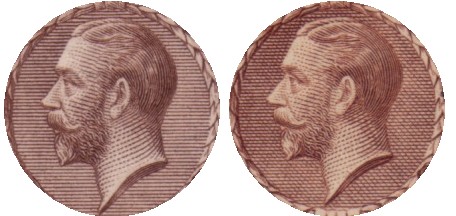

| (SG №) | denomination | colour | date of issue | Printer | number issued |
|---|---|---|---|---|---|
| 99 | 2s6d | Chocolate Brown | March 1935 | Harrison and Somerset House of London | |
| 100 | 5s | Bright Rose Red | March 1935 | Harrison and Somerset House of London | |
| 101 | 10s | Indigo | March 1935 | Harrison and Somerset House of London |
| Varieties | ||
|---|---|---|
References specific to this and related chapters
GBOS GB Overprints Compendium edition 8, Dr John Gledhill (12/4/2020)
Particular thanks go to Stanley Gibbons Ltd, for permission to quote their catalogue numbers and numerous other contributors who are mentioned in the Appendix section.
All content is copyright, Dr John Gledhill and the GB Overprints Society, May 2025.
